In 2002, the ArTrain was displayed in Hillsboro, Oregon, on the tracks of the Portland & Western in SW Washington Street from June 29 until July 4. ArTrain USA was founded in 1971 by the Michigan Council for the Arts in Ann Arbor, Michigan. Initially intended to operate only in Michigan, it began operating beyond Michigan in 1973. The train made three-year tours of the continental United States to display art exhibits in towns across the country. This exhibit was called “The Artistry of Space,” a collection of 78 pieces of NASA artwork from the Smithsonian Air & Space Museum in Washington DC and the Kennedy Space Center in Florida by artists such as Andy Warhol, Norman Rockwell, Peter Max, and Robert Rauschenberg among others.
Since its founding in 1971, the ArTrain has used a variety of rail equipment. In 2002 the ArTrain consisted of four converted streamlined passenger cars and a caboose. The ArTrain cars were purchased from Illinois Transit Assembly. Three of the passenger cars were used as gallery cars while the fourth served as the gift shop and studio. The caboose was used as an office for the onboard staff and as an apartment for a staff member while the train was in transit.
ARTX #101 was built by the Budd Company in December 1948 as a sleeping car for the New York Central. It was originally named Missouri Valley and featured 10 roomettes and six double bedrooms. It was part of a group of cars that were originally assigned to the New England States, the Ohio State Limited, the Southwestern Limited, as well as general service. In 1950, the New York Central assigned five-digit numbers to all of its lightweight sleeping cars, although the numbers weren’t actually applied to the cars until after they had been withdrawn from Pullman service in 1958. This car was assigned #10136. It became Penn Central #4276, and then Amtrak #2836.
ARTX #102 and #103 were built by the Budd Company in July 1949 for the Pennsylvania Railroad. Each car formed one part of a twin-unit dining-kitchen-dormitory car. Seven such twin-unit dining-kitchen-dormitory cars were built and assigned to the Broadway Limited, the General, and other trains. Each unit consisted of a 68-seat dining table car with a four seat waiting room, and a kitchen car with dormitory space for 19 crew members. While designed to operate as a set, the units were separate cars and not articulated. The cars were numbered 4610-4623; the dining units had even numbers and the dormitory-kitchen cars had odd numbers. ARTX #102 was originally Pennsylvania Dormitory-Kitchen Car #4621. It later became Penn Central #4621 and then Amtrak #8805. ARTX #103 was originally Pennsylvania Dining Table Car #4618, and was later Penn Central #4618.
ARTX #104 was built by the Budd Company in September 1947 for the New York Central as Baggage-Dormitory Car #8976. It was retired in 1968 and sold to Ringling Brothers and Barnum & Bailey Circus. It went to the New Orleans Chapter of the National Railway Historical Society in the 1980s, then to the Seminole Gulf Railway in 1989.
ArTrain Caboose ARTX #0005 was built in 1971 as Detroit, Toledo & Ironton #141. The Detroit, Toledo & Ironton was acquired by the Grand Trunk Western in 1980, and was merged into the Grand Trunk Western in 1983. ArTrain acquired the caboose from Grand Trunk Western in 1994.
The ArTrain was pulled from Brooklyn Yard to downtown Hillsboro by 4449 on June 28. 4449 remained in Hillsboro until the end of the ArTrain’s exposition on July 4.
A member of the fourth type of Southern Pacific's "General Service" or "Golden State" 4-8-4 locomotives (the GS-4 Class), it was built in 1941 for glamorous service pulling Southern Pacific's premier Daylight streamlined passenger trains in Southern California, it too found itself replaced by diesels and was retired on October 2, 1957 and donated to the City of Portland, Oregon on April 24, 1958 and placed on display at Oaks Park with SP&S #700 and Union Pacific #3203. It would be the only Daylight steam locomotive to survive (though similar Southern Pacific non-streamlined GS-6 Class 4-8-4 #4460 also survives and is on display at the National Museum of Transport in Kirkwood, Missouri, it never wore Daylight colors). While in the park, a railroad employee named Jack Holst voluntarily kept the moving parts of the three locomotives oiled until his death in 1972. This would set the stage for #4449's resurrection.
In the early 1970s, as America's Bicentennial approached, Ross Rowland, Jr., with help from actor John Wayne, began planning a steam-powered museum train of American artifacts called the American Freedom Train that would travel the United States in celebration of the Bicentennial in 1976. By 1973, the project was underway, but a locomotive still had to be chosen. A number of locomotives were considered, including Union Pacific #8444, but in the end, Southern Pacific #4449 was selected to be the American Freedom Train's primary locomotive. On December 14, 1974, #4449 was removed from Oaks Park and moved to Burlington Northern's Hoyt Street Roundhouse near Union Station for restoration.
Though #4449 would actually be one of three steam
locomotives that pulled the Freedom Train, it would become the most famous, at
it pulled the train throughout the American Midwest and West. Former Reading
Railroad #2101 (as AFT #1) was used in the east and former Texas & Pacific
#610 was used in Texas. The Freedom Train opened in Wilmington, Delaware on
April 1, 1975. As it was in the east, it began its tour with the AFT #1.
Meanwhile, newly restored #4449's boiler is put to steam on April 18 for the
first time since 1957. She moves under her own power on April 21, and was
christened on May 16. She left Portland on June 20 to take over the Freedom
Train in Chicago on August 4, after display stops in Sacramento and Ogden (and
an unfortunate encounter with a dump truck in Nebraska). #4449 will pull the
Freedom Train for the rest of its tour until it ends in Miami on December 31,
1976, except for a brief period in the fall of 1975 when the Freedom Train was
pulled by diesels while #4449 was undergoing repairs, about a month in
February-March 1976 when Texas & Pacific #610 pulls the Freedom Train in
Texas, and four months in the summer when it is pulled on the East Coast again
by AFT #1. After the Freedom Train tour, #4449 returned to Portland by pulling
a series of Amtrak excursions across the South and West in April, 1977, still in
its Freedom Train paint but with the "Amtrak" name added to the
tender. This was known as the "Amtrak Transcontinental Steam
Excursion." #4449 arrived in Portland on May 1, having visited at least 30
states (many more than once) during its Freedom Train and Amtrak Excursion
travels, and was placed in storage, although this time it would be stored
indoors, protected from the elements.
For more information about the American Freedom Train, visit The Museum of America's Freedom Trains.
In 1981, #4449 emerged, restored to the post-WWII
version of its Daylight paint (with "SOUTHERN PACIFIC
" in large lettering in the orange band) to travel to Railfair at the
newly-opened California State Railroad
Museum in Sacramento. It would retain this paint scheme
for nearly 20 years (far longer than it had worn it while in regular service
& even longer than the locomotive had even been IN regular service), as its
travels included a trip to New Orleans to promote the 1984 World's Fair, a trip
to Hollywood to be featured in the 1986 motion picture Tough Guys, a trip to Los Angeles to be a guest at the 50th Anniversary of
the Los Angeles Union Passenger Terminal in 1989, additional trips to
Sacramento for the 1991 and 1999 Railfairs, and numerous excursions in the
Pacific Northwest.
In 2000, #4449 had the opportunity to pull Burlington Northern Santa Fe's Employee Appreciation Special. As BNSF didn't want to have a
locomotive painted for one of the predecessors of its competition, #4449 had to
be painted black with white pinstripes and BNSF heralds for the trip. After the
BNSF trip, the black scheme was modified to recall the all-black paint applied
during World War II as a cost saving measure and to make locomotives less
visible in the event of an aerial attack by the enemy.
In 2002, rather than retuning to Daylight paint, #4449 returned to its American Freedom Train paint in remembrance of the September 11, 2001 terrorist attacks.
During the ArTrain’s exposition, #4449 made at least one short excursion run along the Portland & Western rail line south down SW Adams Street to at least the wye junction with the line between Beaverton and Forest Grove.
The ArTrain was displayed near the end of the Westside Line of TriMet’s MAX light rail system. The line to Hillsboro opened on September 12, 1998. In conjunction with the opening of the Westside Line, MAX also introduced its new Type 2 light rail cars numbered 201 to 252. These Siemens SD-660 light rail vehicles began operation on August 31, 1997, and were the first low-floor light rail vehicles in North America. Pictured here is TriMet MAX Type 2 Siemens SD-660 #237 turning across the westbound lane of SW Washington Street toward the Hillsboro station.
The end of the Westside Line is the Hatfield Government Center station, adjacent to the Washington County Courthouse, the Hillsboro Civic Center, and the Hillsboro Post Office. TriMet MAX Siemens SD-660 light rail vehicles #245 and #228 are pictured here at the Hatfield Government Center station.
Having turned at the Hillsboro wye, #4449 returned with its train. This train consisted of the Yes, Dear, the Clackamas River, and the Plum Creek. DLMX #5811, Yes, Dear, was originally Union Pacific RPO/Postal Storage Car #5811. It was one of three built by American Car & Foundry in 1949. Union Pacific transferred it to maintenance of way service as #903672 in 1973. It was sold to Doyle McCormack for use as #4449’s tool car in 1985. DLMX #9201, the Clackamas River, was built in 1941 for the Southern Pacific, Union Pacific and Chicago & North Western's City of San Francisco as 10 roomette-5 bedroom sleeper Rincon Hill. It was transferred to SP in 1947 as #9201 & was retired in 1966. The Friends of SP 4449 acquired it in 1990 from a private individual in North Dakota for use as #4449’s crew sleeper. Though an SP car, the Daylight paint isn't correct as it was only used on day trains, not sleeping cars.
DLMX #1210, Plum Creek, was built in 1950 by American Car & Foundry for the Great Northern Railroad. It was originally a 60-seat, short-distance coach. 1210 is the car's original number. Unlike many passenger cars, this coach was not sold to Amtrak and remained with the Great Northern's successor, Burlington Northern, who removed the coach seats in 1977 to use the car as a mobile classroom, though the car's original overhead luggage racks and lighting remain. In 1981, the car was sold and was kept in Minnesota, where it was named Plum Creek, until 1999, when it was purchased by the Friends of SP #4449 for use as a parlor/lounge car. Though it wears its original number of 1210, the car's official number, which can be found in small lettering on the side of the car, is PPCX #800235. It is maintained in its original Omaha Orange and Pullman Green of the Great Northern Railroad.
Also nearby, but not part of the train, was DLMX #5659, Gordon N. Zimmerman, aka PPCX #800634, in service as a concession car. It was built by American Car & Foundry in April, 1954 as Union Pacific Baggage Car #5659. It was renumbered to UP #24427 in April 1969 and to UP Maintenance of Way #904227 in 1975. It was purchased from Union Pacific by the Friends of SP #4449 in July, 1997. It initially operated in light gray paint with a black roof and wore the name Better Idea. It was later painted in Daylight colors and renamed Gordon N. Zimmerman, after a crew member who has been an active volunteer co-coordinating and selling souvenirs on every SP #4449 trip since 1981 and helping to restore 1937 Daylight car SP #3300, former UP mail car #5811, now #4449's tool car and #9201 Clackamas River, #4449's crew sleeper. The Gordon N. Zimmerman was making its debut with #4449 at the ArTrain display.

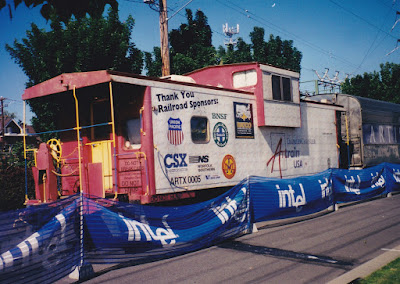
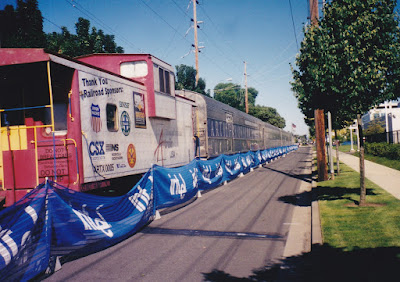
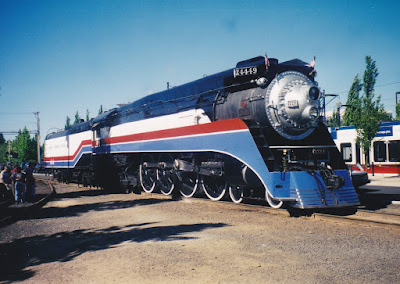
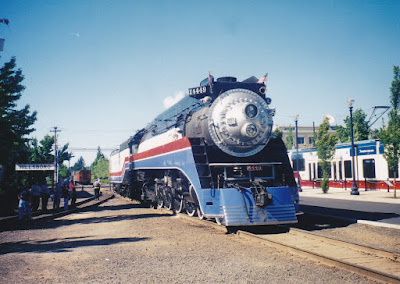

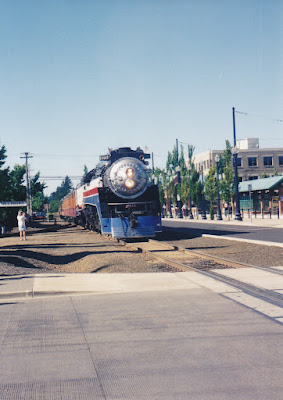
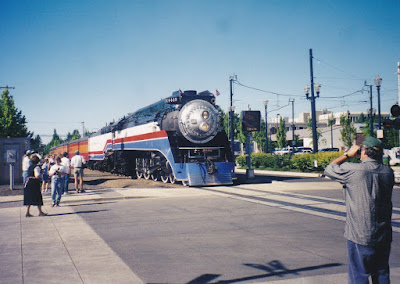
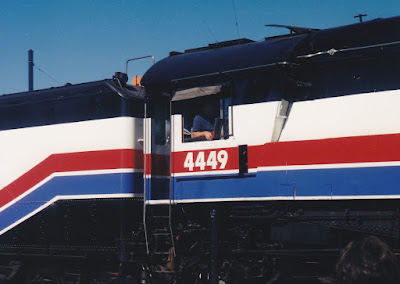
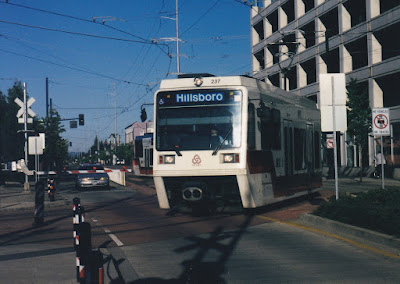
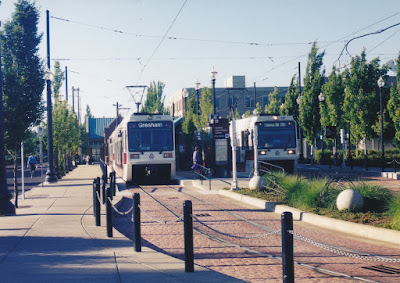
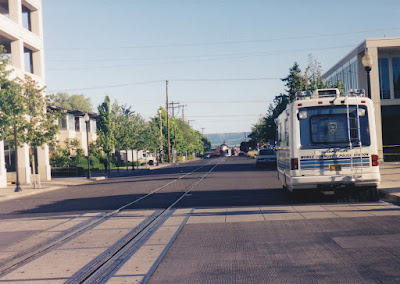

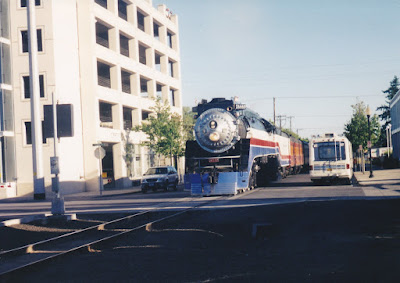
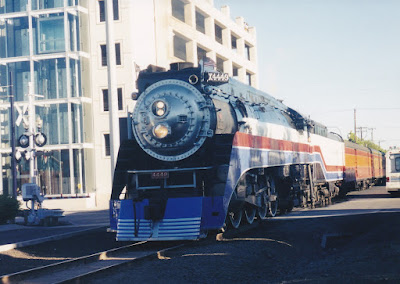
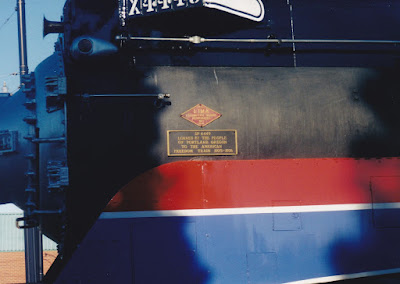
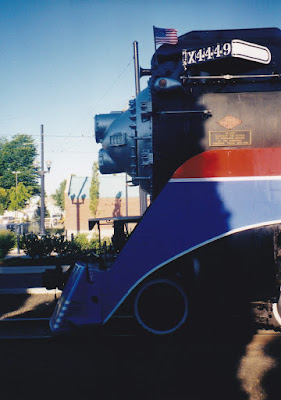
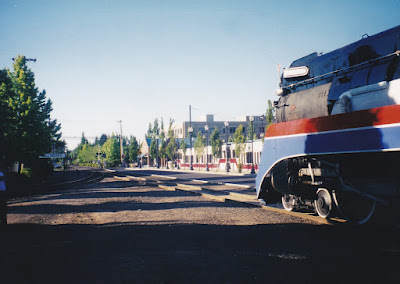
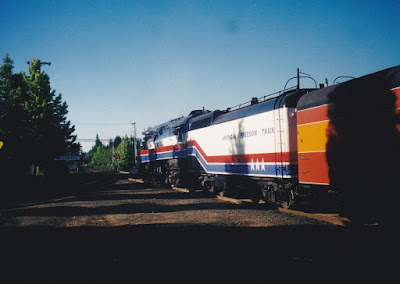
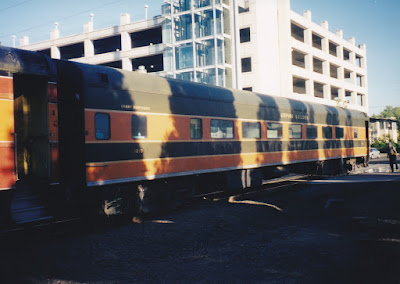
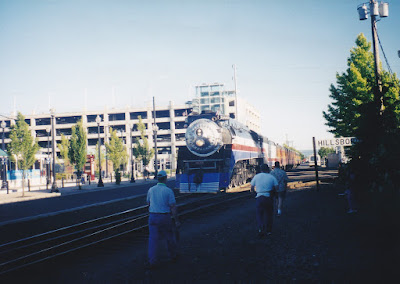
No comments:
Post a Comment